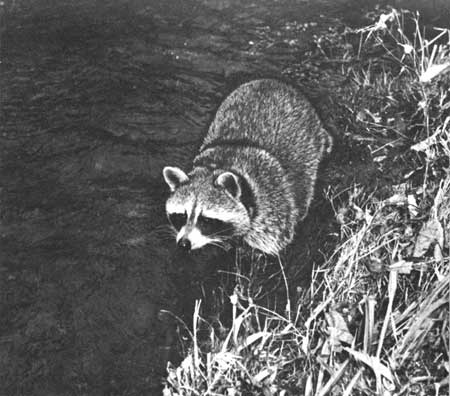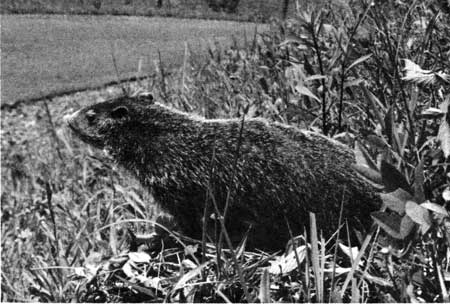|
GREAT SMOKY MOUNTAINS National Park |
 |
Other Mammals
The southern Appalachian Mountains, although noted for the richness of their plantlife, have not harbored a rich variety of fur bearing animals. The larger mammals, particularly, are few. A visitor to Great Smoky Mountains National Park, after seeing black bears along the transmountain road and white-tailed deer in Cades Cove, is not likely to observe any other species whose size exceeds that of a woodchuck. At night, however, automobile headlights may reveal a gray or red fox, an opossum, a raccoon, and, on rare occasions a bobcat on or near the road.
 White-tailed deer are quite common in Cades Cove and vicinity but are rare elsewhere in the Smokies. Since some of them appear to be attracted by lights, motorists should use caution while driving at night. Courtesy, Tennessee Conservation Department. |
In years gone by the bison, elk, mountain lion, wolf, otter, and fisher found a home in these mountains, but long before the establishment of a National Park here these animals had disappeared. It is unlikely that any of them were ever very plentiful.
The fact that at least 50 kinds of native mammals are known to dwell in the park may be somewhat surprising. Of that number almost half (24) belong to the family of rodents, or gnawing animals.
 Raccoons are at home in shallow water, where much of their food, such as crayfish and frogs, is to be found. Their normal time of activity is during the hours of darkness. Courtesy, Tennessee Conservation Department. |
Woodchucks are the park's largest rodents and the ones most likely to be observed by the motorist. These animals frequent the grassy road-shoulders where mowing operations serve to perpetuate their preferred kind of food. Although appearing to pay little or no attention to passing vehicles, these "groundhogs," or "whistle-pigs," are very much on the alert, as visitors who have attempted to approach them on foot will testify.
They pass the coldest part of the winter in hibernation—a trait shared by other rodents such as the jumping mouse, of which two kinds occur in the Smokies, and the eastern chipmunk, the park's only ground-dwelling squirrel.
 The woodchuck, also called groundhog and whistle-pig, is the largest of the park's rodents. |
The muskrat is mostly absent over much of the park, owing to the scarcity of its proper habitat. However, in some places near the boundary, where the streams have a lesser gradient, this semi-aquatic rodent may become fairly plentiful.
 The bobcat, along with all native wildlife, is given full protection in National Parks. These wary, nocturnal animals are seldom seen, but they are not as rare as might be supposed. Courtesy, Tennessee Conservation Department. |
Of the tree-inhabiting squirrels, the "boomer," or red squirrel, is most frequently encountered in the high-altitude forests; like its cousins in New England, Canada, and the Far West, this animal is small in size and big in voice and actions. Boomers are often observed perched on the rims of roadside garbage cans in the higher Smokies. Gray squirrels, similar in appearance to those which accept tidbits from the hand of city-park visitors, are generally distributed throughout forests at low and middle altitudes; in years when acorns are scarce, these squirrels migrate out of the area in search of food. Fox squirrels are rare; they have been observed only in a few places along the northern boundary of the park. Flying squirrels, of which two species occur, are seldom seen by mankind, owing to their nocturnal habits. Their progress through the air is by no means a true flight; actually they should be termed "gliding" squirrels.
 Large eyes and soft, silky fur distinguish the flying squirrels. They sleep during the daylight hours, often choosing a hollow, dead chestnut tree for their home. Courtesy, Tennessee Conservation Department. |
To complete the list of park rodents, mention should be made of the cottontail, whose numbers vary considerably from year to year. Also, there are nine species of wild mice and three native rats.
The omnivorous opossum is fairly common at low and middle altitudes. Like the bear, it displays considerable interest in the contents of garbage cans in campgrounds and along roadsides. Three species of moles, seven or eight shrews, seven bats (the only mammals capable of true flight), the longtail weasel, the mink, and two skunks complete the list of native mammals known to inhabit the park.
 The vast sweep of the Great Smokies, revealed to the viewer but usually subdued in ordinary photographs, is strikingly recorded on haze-penetrating infrared film. |

|

|
|
|
|
Last Modified: Sat, Nov 4 2006 10:00:00 pm PST |


